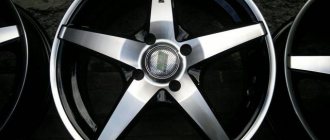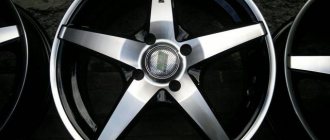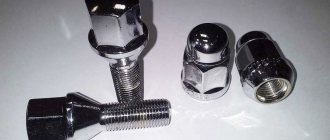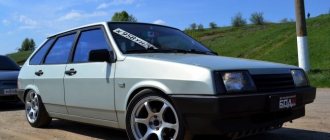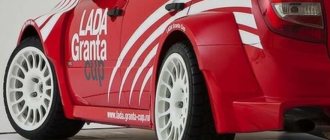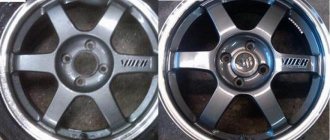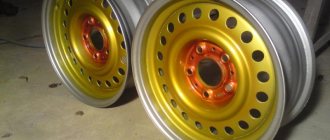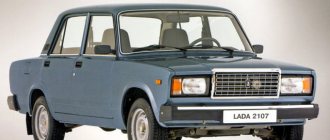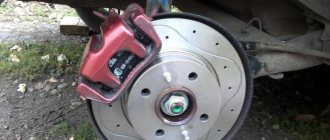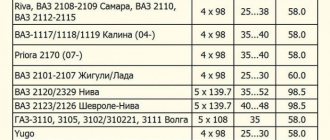The weight of the disc is not related to safety. For safety, it is important that the disc is intact, level, balanced and attached to the hub with the correct fasteners and the correct clamping torque. And if so, almost no one looks at the weight when buying new discs.
In this video we tell you who and why should still take into account how much disks weigh. Plus, we put stamped, cast and forged wheels of different diameters on the scales to accurately represent the difference in kilograms. If watching is uncomfortable, read the text version under the video.
Join us on Instagram, Facebook, VKontakte or Odnoklassniki to stay up to date with news, competitions, discounts and promotions. More interesting information about tires and cars is on our YouTube channel.
How much does a 14 radius aluminum wheel weigh?
For example, for a BMW 7, a steel wheel weighs 9 kg, a cast aluminum wheel weighs 7.8 kg, and a forged aluminum wheel weighs 6.8 kg. Discs come in different diameters: from 10 to 23 inches. ... How much does a car rim weigh?
| Disc diameter | Weight of one disc in kilograms |
| Steel disc (stamped) | |
| 14 inches (R14) | 4,8 |
| 15 inches (R15) | 5,8 |
| 16 inches (R16) | 6,6 |
Controllability
When the car hits a bump, the wheel takes the impact and transfers it through the shock absorber to the body. In turn, the body with its weight (through the shock absorber) compensates for this impact, and the wheel returns to its original position. The smaller the unsprung mass, the less force is generated by the impact on the body, in addition, less effort is spent when maneuvering. However, if the weight of the body is too small relative to the weight of the wheel (all unsprung elements), then the wheel will not be able to quickly return to its original position, which can lead to loss of control (skidding).
Dynamic characteristics
A vehicle's ability to quickly accelerate and provide effective braking also depends on its unsprung weight. The more the wheels weigh, the more energy is needed to increase the speed of their rotation (which ensures the acceleration of the car), the same applies to the braking process.
How much does a complete R14 wheel weigh?
It turns out that the factory wheel on the Lada Kalina 2 R14 175/65 Kama-217 weighs 13.5 kg.
Interesting materials:
How to add a taskbar to your desktop? How to add a folder to files on iPhone? How to add paste options in Excel? How to add a letter to the white list? How to add a program to trusted Windows 10? How to add a keyboard shortcut in Excel? How to add a link to the Google Chrome home screen? How to add a link to YouTube in Yandex Zen? How to add styles to Lightroom? How to add a Microsoft account on Android?
Sprung and unsprung mass
In order to understand how wheel weight can affect a car's handling, dynamic performance, ride quality and suspension durability, it is necessary to understand what forces act on the car while driving. One of the main parameters that guide engineers when developing a suspension for a particular car model is the ratio of the sprung and unsprung mass of the car. What it is?
A spring (spring, shock absorber strut) is an elastic suspension element that softens the shocks that occur when a car moves over uneven road surfaces. Thanks to this element, impacts are transmitted to the body only to a small extent, which determines the smoothness of the ride and comfort of movement. The sprung mass is the mass of parts of the vehicle that are separated from the road surface by a spring (body), and the unsprung mass is the mass of parts that are located between the road surface and the spring (wheels, tires, hubs, brake system elements).
How do they look
Almost everyone can imagine what stamped wheels look like, since stampings are currently the most common car wheels - about 70 percent of cars use them. And also almost all commercial vehicles are equipped with stamps.
Many consider the appearance of stamped wheels to be their main disadvantage. Indeed, they do not have such a variety of designs as their forged and cast counterparts, and they are all similar to each other. Only the colors can differ radically.
Life time
The level of wear resistance of stamped discs is strongly influenced by two indicators:
- disc deformation while driving;
- corrosion.
This is especially evident on bad roads. Since R14 stamping wheels are made of steel, they are much softer and more ductile than, for example, casting. But in this case it plays into the hands of car enthusiasts. If, when it falls into a hole, the casting cracks and becomes unusable, then the dies will simply be dented. This is not difficult to fix. The disk will simply need to be rolled over the rim and you can continue to use it. For minor damage, you can even handle it yourself with a sledgehammer or hammer. Moreover, you can correct it more than once.
Painted stampings
The second important factor that reduces the service life of dies is that they rust. Accordingly, if the disk becomes very rusty, it will no longer be usable. Therefore, it is important to store car wheels in dry, indoor areas. Painting can also slightly prevent inevitable corrosion.
Thus, it is not possible to clearly name the service life of stamped car wheels. With proper care and careful driving, they can last over 30 years. On the contrary, if, for example, you leave a car disk in a damp place for a long time, it may simply rot in a few years.
How to choose original rims
Popular Russian manufacturer of stampings TZSK. Often on the market you can find products from Chinese Trebl, which are not durable. The largest manufacturer of dies is the Ukrainian plant KrKZ. More expensive options for stamped car wheels are also available. For example, these are KFZ stampings, which are more expensive, but of better quality. Wheels of this brand are presented in basic configurations of the Volkswagen and Toyota concerns.
A large number of car models, especially in the basic configuration, are supplied by the factory with stamped wheels. And that motorist who wants to acquire original wheels must look for products recommended by the manufacturer of his car.
VAZ 2113 on original stamps
Rims weight and suspension durability
The durability of the suspension elements also depends on the weight of the wheel rims (and other unsprung elements). When driving over uneven road surfaces, shocks occur that are absorbed by the suspension. Moreover, not only shock absorbers, if the impact is strong, then other suspension elements also take on part of the impact energy. And the higher the unsprung mass, the greater the load on the suspension. Naturally, increasing the load does not contribute to the durability of the units that take the blows.
Which wheels are lighter (forged, cast, stamped)?
Stamped iron wheels are heavier, which has become a common reason for their replacement with light alloys immediately after purchasing a new car. But iron wheels have a minimal cost, which is why they continue to occupy a strong position in the auto parts market.
Cast wheels made of duralumin alloy are approximately 20% lighter than iron wheels; production development allows you to realize virtually any designer’s imagination. In addition, alloy wheels provide the highest quality cooling of the brake system.
Forged wheels are lighter. Discs made using hot stamping technology, in turn, are 20% lighter than cast discs and 50% lighter than stamped iron discs. The main obstacle to their unquestioned dominance among other types of car wheels is the cost - forged wheels are somewhat more expensive than cast wheels, and much more expensive than iron ones.
Magnesium cast wheels occupy a special space on the market; such wheels are somewhat heavier than forged ones, but significantly lighter than alloy wheels. In general, magnesium disks are not widely used, since they are less durable than alloy disks and are not suitable for repair in case of damage. Magnesium wheels are available to fans of fast driving and brisk maneuvering, as well as owners of sports cars.
see also
Comments 107
NZ SH653(Torus) 6.5Jx16 4Х98 ET32 DIA58.6
Information varies everywhere. So I’m trying to clarify clear data!
Thank you very much, and for your efficiency separately! And 695 on the KiKa website says 7.3 kg, and 451 6.520 kg. (shop.kolesa-kik.ru/catalo...ross-/37551.html?from=app) With all this, 695 is written from the replica series and such weight! Can you tell me what the weight of the industrial wheels on the 2022 Grant-Cross is? I called the factory and they can’t tell you, these wheels are not available in the town, so I’m choosing, and you can’t tell me yet, maybe it’s better to put Slick with studded tires, otherwise She weighs about 10 kg, and where is the best place to buy it?
All unique KiK wheels on Grants/Kalinas weigh approximately 6.5 kg in 15mm diameter. I think it should be similar for Granta Cross if the manufacturer is K&K. Slik is just a little lighter. Whether on theirs or on industrial ones, the assembled wheel will weigh up to 15 kg.
Wheel K&K KS451 (Kalina Sport) 6Jx15 ET30, 4x98, DIA58.6: and rim KS695 (15_KALINA-CROSS) could you give a hint about the clean weight of these wheels, without tires?
Both wheels weigh approximately 6.5 kg.
Yaroslav, thanks for the information!
Thank you for your feedback. Glad you needed the information.
A huge THANK YOU to the creators! The most useful thing, based on the weight of the discs, that I have ever seen!
Thanks for your feedback!
dear ones, I’m a little clueless about this topic, please explain... I have 14 stamps with tires 185-60 r14 on a viburnum. If you put, for example, casting on 13 relatively light and tires that are not heavy on 13 175-70, I’ll notice a really increased traction and acceleration or something like that a little? And also the second question is reversed, if you switch to light 15e (like Kalina Sport 5.5j) + light tires like 185-55 (example stated Kormoran Road Performance 185/55 R15 82V weighs 6.75 kg, I’ll lose a lot in dynamics and acceleration and fuel consumption?
Nothing particularly good will happen when switching to 13″ wheels. The increase in traction and dynamics will be virtually unnoticeable (faster, even completely unnoticeable), there may be a slight improvement in rolling (depending on the tires) and a decrease in fuel consumption (up to 0.5 liters, or even less, again depending on the tires). But taxiing will become much worse.
Likewise, nothing disgusting will happen when installing 15″ drives. If the wheels are moderately light and the tires are 185, then the dynamics remain at the same level, as does the fuel consumption. But the taxiing will improve.
I advise you to take a closer look at 15″x6J with an offset in the range of 30-35, and with 185/60 R15 tires with an overload index of 84.
For me, fuel economy is more important than far-fetched comfort on uneven roads! We said nothing within the limits of 0.5 liters. This is quite a lot and excellent! Why do I need the languid 6j, they are bigger for 195 tires! 5.5j is lighter! And 60 profile tires are heavier? There is a theoretical consumption calculator! gaidi.ru/kalkulyatory/kal…sxod-topliva-kalkulyator/
Everything I wrote is the best ending. In the main (in approximately 95% of cases) there are no configurations, not counting aspects. So let's go the other way. Tell us what specific tire and wheel options you are considering. And I’ll tell you the effect of installing them.
Well, here, looking at what the final size is. The small size attracts with the price of tires, wheels and, of course, fuel efficiency + quick starts without strain! And I don’t understand what’s great about wide ones, not counting the type and type of durability on the highway (theory again)… and there are a lot of disadvantages! It’s a small thing for someone to overpay for 0.5 liters per 100, but it’s unpleasant for me, taking into account the already precious 15 tires and wheels. I wish I could put on the 13s, but they don’t fit the 14 calipers, the casting says it’s going to fit, it’s necessary to measure. Do you have experience to clearly say that at 175-70 r13 it will be much worse than 185-60 r14 for example? Or again depends on the tires, etc. By the way, I consider tires from completely cheap ones like Viatti and Kama Breeze to average ones for 2200 rubles like Nexen or Cordiant, no more!
Then your option is to stay at 14″, but switch to 175/65 R14. In this case, this is the most economical option. Regular 13″ tires cost the same as 14″ ones. If you take a cheap one, then there will be no savings in consumption, because... Simply put, the rolling resistance of such rubber is higher. Therefore, in the worst case scenario, you can even increase fuel consumption.
yes, I’m thinking about 175-65, but won’t it be very bad on the highway, some write that they only give economy and pass speed... the rest say that driving them on the highway is terrible compared to 185-60! who to believe...
There will be no horror when switching to 175/65.
